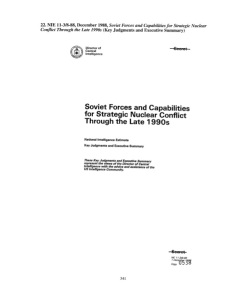By Greg Thielmann
The intelligence community may have missed the impending collapse of Moscow's empire in the late 1980s, but the Worldwide Threat Assessment presented to the Congress earlier this month by Director of National Intelligence James Clapper certainly reflects an awareness that Russia today is no longer an enemy of the United States. How else to explain that Clapper's 27-page Statement for the Record makes no mention of Russia's nuclear arsenal?
 Cover photo of the NIE 11-3/8-88, December 1988, Soviet Forces and Capabilities for Strategic Nuclear Conflict Through the Late 1990s.
Cover photo of the NIE 11-3/8-88, December 1988, Soviet Forces and Capabilities for Strategic Nuclear Conflict Through the Late 1990s.
While Soviet nuclear forces had pride of place during the Cold War as the great existential threat, the 2014 threat survey leads with "cyber," includes eight other major categories, including "natural resources" and "health risks," and dissects 30 specific regional threats. But it never explicitly draws attention to the nuclear arsenal that could annihilate the United States and fundamentally alter life on the Planet Earth. The obvious explanation for this omission is that the intelligence community regards the chances of a Russian nuclear attack to be so remote that it is not worth mentioning.
Russia today is the country that provides the United States nuclear power reactor fuel fashioned from the weapons previously pointed at U.S. targets and the country that uses its rockets to transport American astronauts to and from the International Space Station.
In this context, it is worth noting that U.S. strategic forces are still structured and poised to deal with the most alarming nuclear threat perceived in the Cold War – a disarming nuclear first-strike directed by Moscow against the United States. The current U.S. nuclear stockpile includes nearly 2,000 operational strategic warheads, a significant portion of which (all Minuteman III intercontinental ballistic missiles and the Trident strategic ballistic missiles on board 4-5 submarines) are on continuous alert, ready for launch in minutes.
Although President Obama has declared that the United States can safely cut U.S. strategic forces by a third, it is actually reducing its operationally deployed strategic warhead totals at a very slow rate, still above the New START limits established three years ago, and is expanding its lead over the more rapidly declining level of Russian strategic forces to nearly 300 deployed strategic warheads.
U.S. strategic nuclear forces make little contribution toward dealing with most of the threats described in this year's Worldwide Assessment. Indeed, these forces make some threat categories, like cyber and terrorism, more worrisome because they represent vectors toward illicit control over the enormous power contained in nuclear weapons.
Moreover, U.S. planning for future defense forces anticipates retaining and modernizing all three legs of the triad at a currently programmed ten-year cost of some $355 billion. In an era of increased pressure on the defense budget, this enormous funding wedge cuts deeply into resources otherwise available for meeting the diverse challenges identified in the Worldwide Threat Assessment. Last year's sequestration maneuvers included suspending B-52 pilot training for those assigned conventional missions in order to retain training for those assigned to nuclear missions. The navy is hard-pressed to sustain its desired schedule for multi-role attack submarine construction, because of the competing priority given to funding replacement of Trident nuclear ballistic missile submarines.
Some of Washington's closest allies are confronting more forthrightly this disconnect between updated threat assessments and traditional force posture. A leading U.K. think tank (RUSI), recently published a report saying Britain could still maintain a solid nuclear deterrent even after a reducing its ballistic missile submarine fleet from four to three boats. According to the report's author, Hugh Chalmers: "Our own national security assessment is...that we don't see a state-based nuclear threat."
However inconceivable the prospect of a deliberate Russian attack, both Washington and Moscow must still do everything possible to address the remote chance of an accidental or unauthorized use of nuclear weapons. 50th anniversary retrospectives on the dark film comedy, "Dr. Strangelove," remind us that Cold War fail-safe systems were not nearly as iron-clad as the U.S. military described at the time and that the risks of non-deliberate nuclear detonation has not yet been completely eliminated.
If those formulating national force posture and policies have been slow to notice the implications of declining traditional threats, the nuclear-armed missile operators and bomber crews have brought it to the attention of the public in dramatic new ways. Morale problems and performance appear to be symptoms of a wider malaise. For U.S. Secretary of Defense Hagel to profess himself "deeply concerned" about "the overall health, and the professionalism, and discipline of our strategic forces" is a sobering commentary, which should lead to corrective actions beyond the personnel sphere.
One of the most important jobs of the intelligence community is to analyze objectively the most serious threats facing the country. It is the job of others to draw appropriate conclusions regarding the obvious disconnect between the Worldwide Threat Assessment and U.S. nuclear force posture. A long-overdue task of U.S. political leadership is to bring the size and posture of the U.S. nuclear arsenal into alignment with the threat. This means moving expeditiously to a smaller nuclear force at a lower state of readiness.
